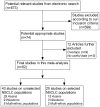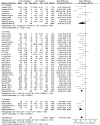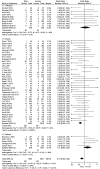Clinicopathological and demographical characteristics of non-small cell lung cancer patients with ALK rearrangements: a systematic review and meta-analysis
- PMID: 24959902
- PMCID: PMC4069179
- DOI: 10.1371/journal.pone.0100866
Clinicopathological and demographical characteristics of non-small cell lung cancer patients with ALK rearrangements: a systematic review and meta-analysis
Abstract
Objective: This meta-analysis aimed to comprehensively examine the relationship between the clinicopathological and demographical characteristics and ALK rearrangements in patients with non-small cell lung cancer (NSCLC).
Methods and main findings: In total, 62 qualified articles including 1178 ALK rearranged cases from 20541 NSCLC patients were analyzed, and the data were extracted independently by two investigators. NSCLC patients with ALK rearrangements tended to be younger than those without (mean difference: -7.16 years; 95% confidence interval (95% CI): -9.35 to -4.96; P<0.00001), even across subgroups by race. Compared with female NSCLC patients, the odds ratio (OR) of carrying ALK rearrangements was reduced by 28% (95% CI: 0.58-0.90; P = 0.004) in males, and this reduction was potentiated in Asians, yet in opposite direction in Caucasians. Likewise, smokers were less likely to have ALK rearrangements than never-smokers (OR = 0.33; 95% CI: 0.25-0.44; P<0.00001), even in race-stratified subgroups. Moreover, compared with NSCLC patients with tumor stage IV, ALK rearrangements were underrepresented in those with tumor stage I-III (OR = 0.58; 95% CI: 0.44-0.78; P = 0.0002). Patients with lung adenocarcinomas had a significantly higher rate of ALK rearrangements (7.2%) than patients with non-adenocarcinoma (2.0%) (OR = 2.25; 95% CI: 1.54-3.27; P<0.0001).
Conclusion: Our findings demonstrate that ALK rearrangements tended to be present in NSCLC patients with no smoking habit, younger age and tumor stage IV. Moreover, race, age, gender, smoking status, tumor stage and histology might be potential sources of heterogeneity.
Conflict of interest statement
Figures
Similar articles
-
Targeted therapy for advanced anaplastic lymphoma kinase (<I>ALK</I>)-rearranged non-small cell lung cancer.Cochrane Database Syst Rev. 2022 Jan 7;1(1):CD013453. doi: 10.1002/14651858.CD013453.pub2. Cochrane Database Syst Rev. 2022. PMID: 34994987 Free PMC article.
-
Clinicopathologic characteristics of ALK rearrangements in primary lung adenocarcinoma with identified EGFR and KRAS status.J Cancer Res Clin Oncol. 2014 Mar;140(3):453-60. doi: 10.1007/s00432-014-1584-8. Epub 2014 Jan 18. J Cancer Res Clin Oncol. 2014. PMID: 24442099 Free PMC article.
-
Prevalence and clinicopathological characteristics of ALK fusion subtypes in lung adenocarcinomas from Chinese populations.J Cancer Res Clin Oncol. 2016 Apr;142(4):833-43. doi: 10.1007/s00432-015-2081-4. Epub 2015 Dec 8. J Cancer Res Clin Oncol. 2016. PMID: 26646246 Free PMC article.
-
TP53 or CDKN2A/B covariation in ALK/RET/ROS1-rearranged NSCLC is associated with a high TMB, tumor immunosuppressive microenvironment and poor prognosis.J Cancer Res Clin Oncol. 2023 Sep;149(12):10041-10052. doi: 10.1007/s00432-023-04924-7. Epub 2023 Jun 1. J Cancer Res Clin Oncol. 2023. PMID: 37261522 Free PMC article.
-
Effect of ALK-inhibitors in the treatment of non-small cell lung cancer: a systematic review and meta-analysis.Eur Rev Med Pharmacol Sci. 2017 Aug;21(15):3496-3503. Eur Rev Med Pharmacol Sci. 2017. PMID: 28829490
Cited by
-
Chaperone-Mediated Autophagy Markers LAMP2A and HSC70 Are Independent Adverse Prognostic Markers in Primary Resected Squamous Cell Carcinomas of the Lung.Oxid Med Cell Longev. 2020 Sep 21;2020:8506572. doi: 10.1155/2020/8506572. eCollection 2020. Oxid Med Cell Longev. 2020. PMID: 33029283 Free PMC article.
-
Regulatory characteristics and pivotal study design of US Food and Drug Administration approval of drugs for major vs. minor cancer.Eur J Clin Pharmacol. 2019 Sep;75(9):1193-1200. doi: 10.1007/s00228-019-02695-0. Epub 2019 May 25. Eur J Clin Pharmacol. 2019. PMID: 31129731
-
Humanistic burden of living with anaplastic lymphoma kinase-positive non-small-cell lung cancer: findings from the ALKConnect patient insight network and research platform.Lung Cancer Manag. 2020 Nov 20;10(1):LMT42. doi: 10.2217/lmt-2020-0018. Lung Cancer Manag. 2020. PMID: 33318754 Free PMC article.
-
Lung cancer family history and exposure to occupational/domestic coal combustion contribute to variations in clinicopathologic features and gene fusion patterns in non-small cell lung cancer.Thorac Cancer. 2019 Apr;10(4):695-707. doi: 10.1111/1759-7714.12987. Epub 2019 Feb 18. Thorac Cancer. 2019. PMID: 30775858 Free PMC article.
-
Influence of Estrogen on the NSCLC Microenvironment: A Comprehensive Picture and Clinical Implications.Front Oncol. 2020 Feb 18;10:137. doi: 10.3389/fonc.2020.00137. eCollection 2020. Front Oncol. 2020. PMID: 32133288 Free PMC article. Review.
References
-
- Lynch TJ, Bell DW, Sordella R, Gurubhagavatula S, Okimoto RA, et al. (2004) Activating mutations in the epidermal growth factor receptor underlying responsiveness of non-small-cell lung cancer to gefitinib. N Engl J Med 350: 2129–2139. - PubMed
-
- Soda M, Choi YL, Enomoto M, Takada S, Yamashita Y, et al. (2007) Identification of the transforming EML4-ALK fusion gene in non-small-cell lung cancer. Nature 448: 561–566. - PubMed
-
- Shinmura K, Kageyama S, Tao H, Bunai T, Suzuki M, et al. (2008) EML4-ALK fusion transcripts, but no NPM-, TPM3-, CLTC-, ATIC-, or TFG-ALK fusion transcripts, in non-small cell lung carcinomas. Lung Cancer 61: 163–169. - PubMed
Publication types
MeSH terms
Substances
LinkOut - more resources
Full Text Sources
Other Literature Sources
Medical




